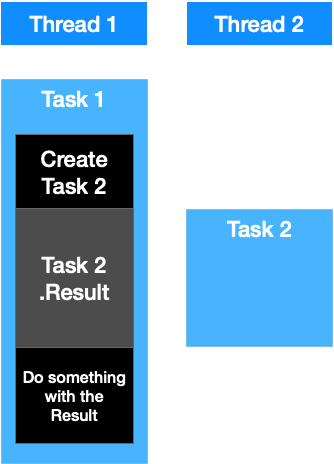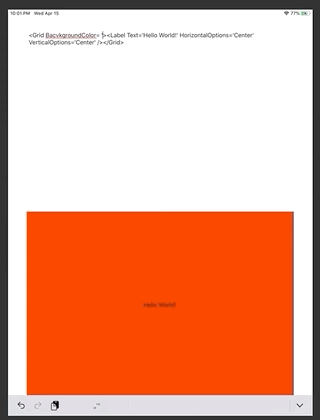Flyouts are a pretty neat control, first introduced in Windows UWP, but there is nothing close in Xamarin.Forms which can be used on all platforms. So I decided to create one.
What is a Flyout?
from the Windows UWP documentation (https://docs.microsoft.com/en-us/uwp/api/windows.ui.xaml.controls.flyout?view=winrt-19041)
“Use a Flyout control for collecting information, for displaying more info, or for warnings and confirmations. Unlike a dialog, a Flyout does not create a separate window, and does not block other user interaction.”
So a Flyout can be attached to whatever control you want, and it will pop up as soon as the item is tapped. There are several use cases it easy fits in:
– show more details in a specific context
– ask for confirmation
– ask for more details
– …
How will the XAML look like?
<Label Text="Hello who?">
<FlyoutBase.AttachedFlyout>
<Flyout BackgroundColor="Red">
<Flyout.DataTemplate>
<DataTemplate>
<Label Text="Hello World!"/>
</DataTemplate>
</Flyout.DataTemplate>
</FLyout>
</FlyoutBase.AttachedFlyout>
</Label>
Looks easy to use, but still needs to be implemented.
Main Challenge: Create a layer over the current content for our Flyout
First we need to add a layer over the whole content of the page, so we can freely place a Flyout on the screen over all other controls. We can achieve that by going up the whole visual tree, find the ContentPage and kinda inject a Grid into it. A Grid is pretty easy to use, and it has the ability to have several Children that arrange in layers one over each other. We need to do this step, because we know nothing about the Layout that is used by the programmer, that created that Page.
FlyoutBase.AttachedFlyout is a AttachedProperty that we can attach to whatever control we need. After the Flyout is attached, we just need to add the TapGesture to that control.
internal class FlyoutRootGrid : Grid {} // just a specific type, to remind it
public class FlyoutBase
{
#region attachedflyout property
public static readonly BindableProperty AttachedFlyoutProperty =
BindableProperty.CreateAttached("AttachedFlyout", typeof(Flyout), typeof(FlyoutBase), null, propertyChanged: OnAttachedFlyoutChanged);
public static Flyout GetAttachedFlyout(BindableObject view)
{
return (Flyout)view.GetValue(AttachedFlyoutProperty);
}
public static void SetAttachedFlyout(BindableObject view, Flyout value)
{
view.SetValue(AttachedFlyoutProperty, value);
}
#endregion
// called whenever a flyout is attached to a view
private static async void OnAttachedFlyoutChanged(BindableObject bindable, object oldValue, object newValue)
{
if (bindable is View view)
{
await Task.Delay(1000); // we wait a little, so the view is attached to the visual tree
// this is very weak, we need to think about a better solution here
AttachFlyout(view);
}
}
private static void AttachFlyout(View view)
{
// find the FlyoutRoot
var flyoutRootGrid = CreateOrFindRootGrid(view);
// and now attach the flyout to it as child
var flyout = AttachFlyoutToRoot(flyoutRootGrid, view);
// register the desture to the visual
view.GestureRecognizers.Add(
new TapGestureRecognizer
{
NumberOfTapsRequired = 1,
Command = new Command(obj => ToggleFlyoutIsVisible(flyout, view))
});
}
// will go through the visual tree up to the content page
// remove the content
// add a "FlyotRootGrid"
// and set the removed content to it as first child
private static FlyoutRootGrid CreateOrFindRootGrid(VisualElement view)
{
var flyOutRootGrid = VisualTreeHelper.FindParentElement<FlyoutRootGrid>(view);
// maybe we already have such a control in the visual tree (perhaps we use more than one flyout)
// so we can reuse it
if (flyOutRootGrid == null)
{
// otherwise attach iot to root
var parentPage = VisualTreeHelper.FindParentPage<ContentPage>(view);
flyOutRootGrid = new FlyoutRootGrid();
var oldContent = parentPage.Content;
parentPage.Content = flyOutRootGrid;
flyOutRootGrid.Children.Add(oldContent);
}
return flyOutRootGrid;
}
private static Flyout AttachFlyoutToRoot(FlyoutRootGrid flyoutRootGrid, View view)
{
// get the flyout from the attached property
var flyout = GetAttachedFlyout(view);
// not visible yet
flyout.IsVisible = false;
// add it to the root grid
flyoutRootGrid.Children.Add(flyout);
return flyout;
}
private static void ToggleFlyoutIsVisible(Flyout flyout, View view)
{
// align flout to the view that has been clicked
// set IsVisible to the flyout
}
}
Now that the Flyout is added to the VisualTree of the ContentPage, we just need to handle the fade in and out of the Flyout. We also have to take care of placing the Flyout correctly on the screen. Therefore we need to find the screen coordinates of the tapped view and position the Flyout accordingly.
private static void ToggleFlyoutIsVisible(Flyout flyout, View view)
{
bool setVisible = !flyout.IsVisible; // checkout the flyout is visible
if (flyout.Content == null && flyout.DataTemplate != null)
{ // when we yet have no content -> create it from datatemplate
flyout.Content = flyout.DataTemplate.CreateContent() as View;
}
if (setVisible)
{
flyout.AlignFlyout(view);
}
flyout.PlayAnimation(setVisible, view);
}
I don’t just want to set the IsVisible property. Let’s do something fancy and add an animation. But first we need to find the coordinates of the tapped control. I found a solution here (https://forums.xamarin.com/discussion/66386/how-to-get-the-coordinates-where-there-is-a-control-on-the-screen) and adjusted it a little to fit my needs. The VisualTreeHelper also includes the FindParentPage-method from a previous blog post.
public static class VisualTreeHelper
{
public static T FindParentPage<T>(Element view)
where T:Page
{
return FindParentElement<T>(view);
}
public static T FindParentElement<T>(Element view, Func<T,bool> predicate = null)
where T:Element
{
if (view is T element)
{
if (predicate == null)
{
return element;
}
if (predicate(element))
{
return element;
}
}
if (view.Parent == null)
{
return null;
}
return FindParentElement<T>(view.Parent, predicate);
}
public static (double X, double Y) GetScreenCoordinates(this VisualElement view)
{
// A view's default X- and Y-coordinates are LOCAL with respect to the boundaries of its parent,
// and NOT with respect to the screen. This method calculates the SCREEN coordinates of a view.
// The coordinates returned refer to the top left corner of the view.
var screenCoordinateX = view.X;
var screenCoordinateY = view.Y;
var parent = (VisualElement)view.Parent;
while (parent != null && parent is VisualElement)
{
screenCoordinateX += parent.X;
screenCoordinateY += parent.Y;
parent = parent.Parent as VisualElement;
}
return (screenCoordinateX, screenCoordinateY);
}
}
Now we can put all together and implement the Flyout
public class Flyout : ContentView
{
public enum AnimationType { Fade, SlideVertical }
public Flyout()
{
HorizontalOptions = LayoutOptions.Start;
VerticalOptions = LayoutOptions.Start;
}
public AnimationType Animation { get; set; }
public DataTemplate DataTemplate { get; set; }
double _targetHeight = -1;
internal async void PlayAnimation(bool setVisible, View view)
{
switch (Animation)
{
case AnimationType.Fade:
if (setVisible)
{
Opacity = 0;
IsVisible = true;
await this.FadeTo(1, 250);
}
else
{
await this.FadeTo(0, 250);
IsVisible = false;
}
break;
case AnimationType.SlideVertical:
if (setVisible)
{
if (_targetHeight == -1)
{
_targetHeight = Height == -1 ? HeightRequest : Height;
}
HeightRequest = 0;
Content.Opacity = 0;
IsVisible = true;
var animation = new Animation(d => HeightRequest = d, 0, _targetHeight);
animation.Commit(this, "Flyout");
await Task.Delay(100);
await Content.FadeTo(1, 55);
}
else
{
await Content.FadeTo(0, 55);
var animation = new Animation(d => HeightRequest = d, Height, 0);
animation.Commit(this, "Flyout2");
await Task.Delay(250);
IsVisible = false;
}
break;
}
}
internal void AlignFlyout(View view)
{
var coords = view.GetScreenCoordinates();
Margin = new Thickness(coords.X, coords.Y + view.Height, 0, 0);
}
}
As always you can use and extend the code, however you like. It’s not complete yet, feel free to fix bugs or extend it.








